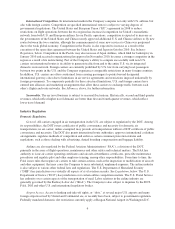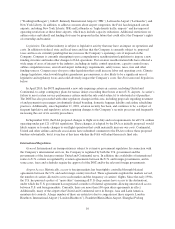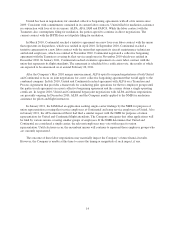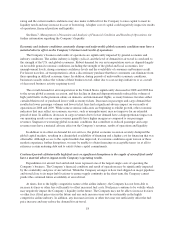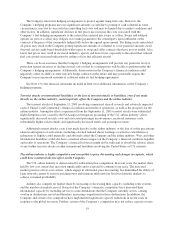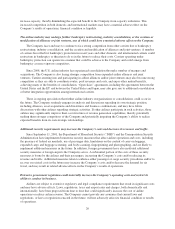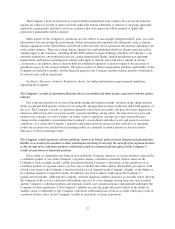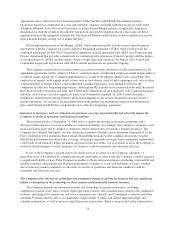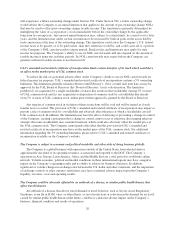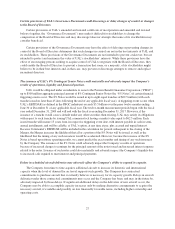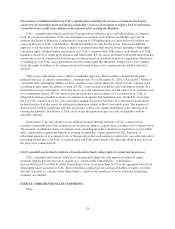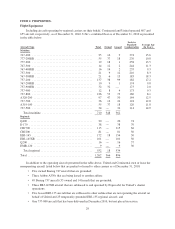United Airlines 2010 Annual Report Download - page 21
Download and view the complete annual report
Please find page 21 of the 2010 United Airlines annual report below. You can navigate through the pages in the report by either clicking on the pages listed below, or by using the keyword search tool below to find specific information within the annual report.The Company enters into hedging arrangements to protect against rising fuel costs. However, the
Company’s hedging programs may use significant amounts of cash due to posting of cash collateral in some
circumstances, may not be successful in controlling fuel costs and may be limited due to market conditions and
other factors. In addition, significant declines in fuel prices may increase the costs associated with the
Company’s fuel hedging arrangements to the extent it has entered into swaps or collars. Swaps and sold put
options (as part of a collar) may obligate us to make payments to the counterparty upon settlement of the
contracts if the price of the commodity hedged falls below the agreed upon amount. Declining crude and related
oil prices may result in the Company posting significant amounts of collateral to cover potential amounts owed
(beyond certain credit-based thresholds) with respect to swap and collar contracts that have not yet settled. Also,
lower fuel prices may result in increased industry capacity and lower fares, especially to the extent that reduced
fuel costs justify increased utilization by airlines of less fuel efficient aircraft.
There can be no assurance that the Company’s hedging arrangements will provide any particular level of
protection against increases or declines in fuel costs or that its counterparties will be able to perform under the
Company’s hedging arrangements. Additionally, deterioration in the Company’s financial condition could
negatively affect its ability to enter into new hedge contracts in the future and may potentially require the
Company to post increased amounts of collateral under its fuel hedging agreements.
See Note 13 to the financial statements included in Item 8 for additional information on the Company’s
hedging programs.
Terrorist attacks or international hostilities, or the fear of terrorist attacks or hostilities, even if not made
directly on the airline industry, could negatively affect the Company and the airline industry.
The terrorist attacks of September 11, 2001 involving commercial aircraft severely and adversely impacted
each of United’s and Continental’s financial condition and results of operations, as well as the prospects for the
airline industry. Among the effects experienced from the September 11, 2001 terrorist attacks were substantial
flight disruption costs caused by the FAA-imposed temporary grounding of the U.S. airline industry’s fleet,
significantly increased security costs and associated passenger inconvenience, increased insurance costs,
substantially higher ticket refunds and significantly decreased traffic and passenger revenue.
Additional terrorist attacks, even if not made directly on the airline industry, or the fear of or the precautions
taken in anticipation of such attacks (including elevated national threat warnings or selective cancellation or
redirection of flights) could materially and adversely affect the Company and the airline industry. Wars and other
international hostilities could also have a material adverse impact on the Company’s financial condition, liquidity
and results of operations. The Company’s financial resources might not be sufficient to absorb the adverse effects
of any further terrorist attacks or other international hostilities involving the United States or U.S. interests.
The airline industry is highly competitive and susceptible to price discounting and changes in capacity, which
could have a material adverse effect on the Company.
The U.S. airline industry is characterized by substantial price competition. In recent years, the market share
held by low-cost carriers has increased significantly and is expected to continue to increase. The increased
market presence of low-cost carriers, which engage in substantial price discounting, has diminished the ability of
large network carriers to exercise pricing power and maintain sufficient fare levels in domestic markets to
achieve sustained profitability.
Airlines also compete for market share by increasing or decreasing their capacity, including route systems
and the number of markets served. Several of the Company’s domestic competitors have increased their
international capacity by including service to some destinations that the Company currently serves, causing
overlap in destinations served and therefore increasing competition for those destinations. In addition, the
Company and certain of its competitors have implemented significant capacity reductions in recent years in
response to the global recession. Further, certain of the Company’s competitors may not reduce capacity or may
19


